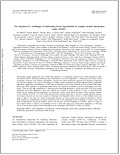| Journal Article |
 |
|
| Article Title | The forgotten D: challenges of addressing forest degradation in complex mosaic landscapes under REDD+ | | Author | Ole Mertz, Daniel Müller, Thomas Sikor, Cornelia Hett, Andreas Heinimann, Jean-Christophe Castella, Guillaume Lestrelin, Casey M. Ryan, David S. Reay, Dietrich Schmidt-Vogt, Finn Danielsen, Ida Theilade, Meine van Noordwijk, Louis V. Verchot, Neil D. Burgess, Nicholas J. Berry, Thu Thuy Pham, Peter Messerli, Xu Jianchu, Rasmus Fensholt, Patrick Hostert, Dirk Pflugmacher, Thilde Bech Bruun, Andreas de Neergaard, Klaus Dons, Sonya Dewi, Ervan Rutishauser and Zhanli Sun | | Year | 2012 | | Journal Title | Geografisk Tidsskrift-Danish Journal of Geography | | Institution | Taylor & Francis | | Volume | 112 | | Issue | 1 | | Pages | 63–76 | | Call Number | JA0454-12 | | Keywords | REDD+; forest degradation; deforestation; mosaic landscapes; forest carbon; greenhouse gases; livelihoods; biodiversity; governance; monitoring; remote sensing |
|
| Abstract: |
| International climate negotiations have stressed the importance of considering emissions from forest degradation under
the planned REDD+ (Reducing Emissions from Deforestation and forest Degradation + enhancing forest carbon stocks)
mechanism. However, most research, pilot-REDD+ projects and carbon certification agencies have focused on deforestation
and there appears to be a gap in knowledge on complex mosaic landscapes containing degraded forests, smallholder
agriculture, agroforestry and plantations. In this paper we therefore review current research on how avoided forest degradation
may affect emissions of greenhouse gases (GHG) and expected co-benefits in terms of biodiversity and livelihoods.
There are still high uncertainties in measuring and monitoring emissions of carbon and other GHG from mosaic
landscapes with forest degradation since most research has focused on binary analyses of forest vs. deforested land.
Studies on the impacts of forest degradation on biodiversity contain mixed results and there is little empirical evidence
on the influence of REDD+ on local livelihoods and tenure security, partly due to the lack of actual payment schemes.
Governance structures are also more complex in landscapes with degraded forests as there are often multiple owners and
types of rights to land and trees. Recent technological advances in remote sensing have improved estimation of carbon
stock changes but establishment of historic reference levels is still challenged by the availability of sensor systems and
ground measurements during the reference period. The inclusion of forest degradation in REDD+ calls for a range of
new research efforts to enhance our knowledge of how to assess the impacts of avoided forest degradation. A first step
will be to ensure that complex mosaic landscapes can be recognised under REDD+ on their own merits. |
|